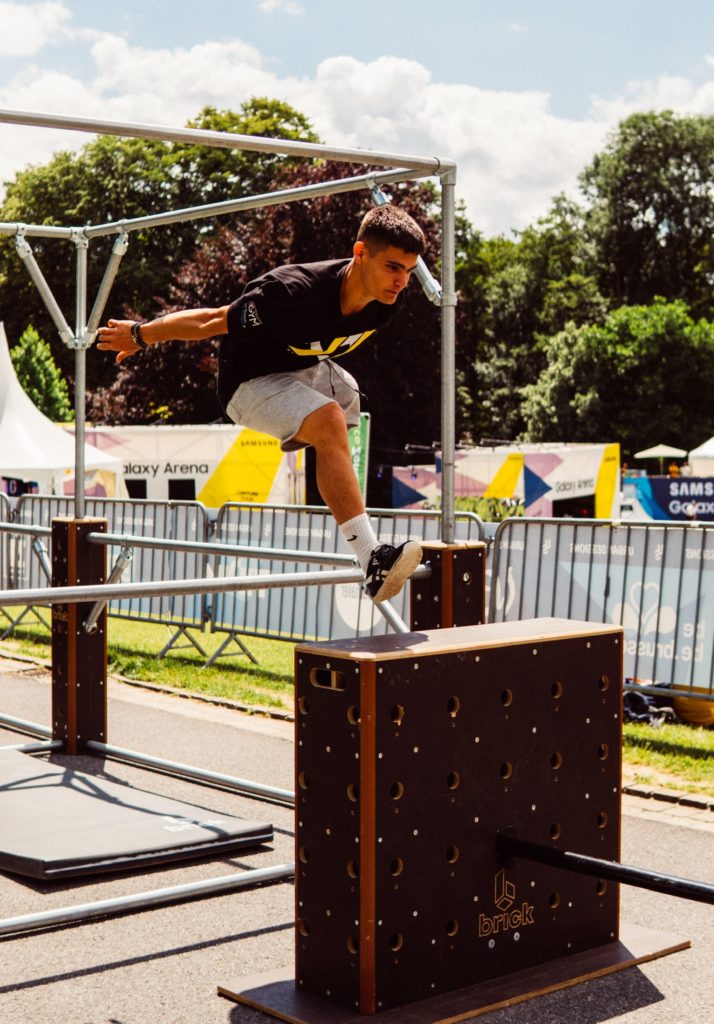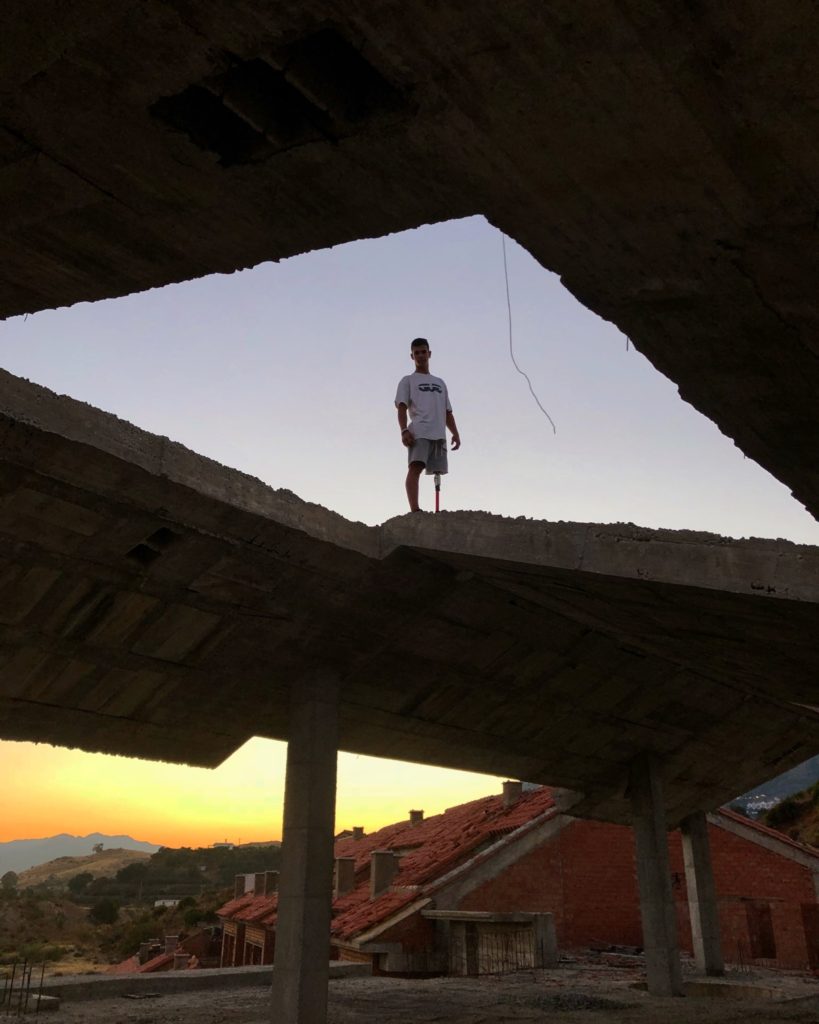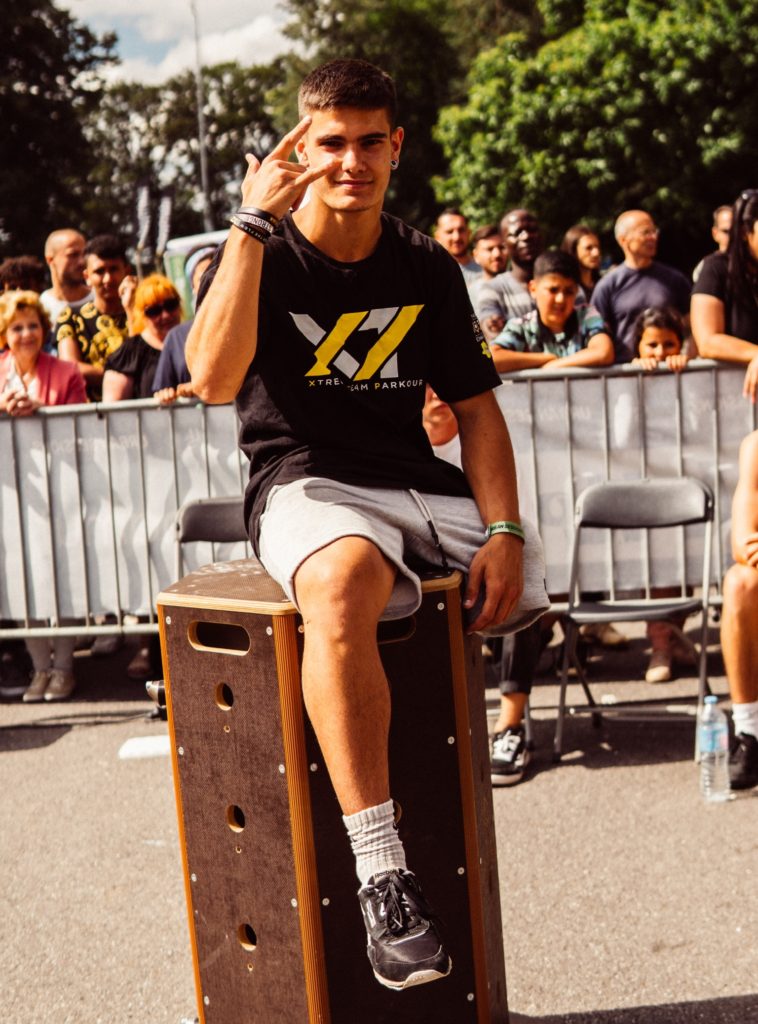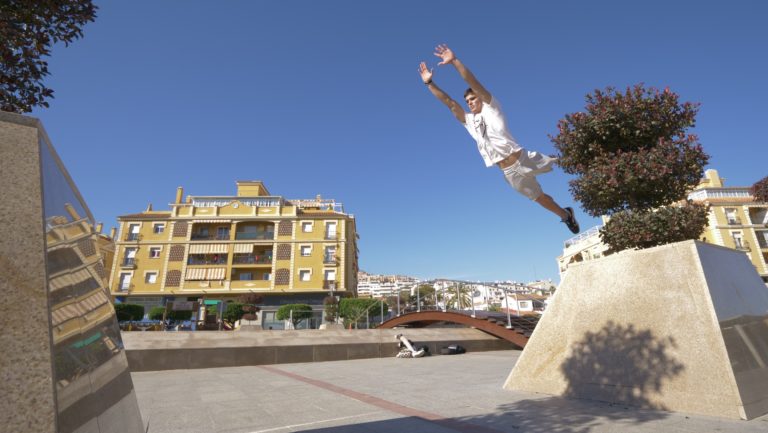Below is an interview we conducted with rising Parkour star Rubén Roldán. If you haven’t heard of Ruben before, trust us: you will never forget him after hearing his story. That’s because the thing that makes Ruben absolutely unique in the world of Parkour is he only has one leg. In spite of the fact that many would consider this a severe limitation, Ruben is tracing at a world class level. He’s a shining example of one of the Parkour ethos – any obstacle can be overcome.
We hope you enjoy this interview and Ruben’s openness and candor about his life, his training, and his goals for his future. We have translated this interview from its original version in Spanish, so please forgive any mistranslations which we are confident will be small.
No matter what people say, you are the one who knows what you can and cannot do. You set your limits.
-Rubén Roldán
Hello Ruben! We are so excited to interview you! Can you please share your name, age and where you are from!
Hello everyone! My name is Rubén Roldán, I am 20 years old and I am from Spain. I live in Malaga, in a town called Rincon de la Victoria.
Can you tell us a bit about your background and how you came to parkour?
Throughout my life I have always liked sports, as a child I played soccer, bmx, scooter and I also loved mountain biking. After the accident and its respective recovery (9 years), I went back to playing soccer as a goalkeeper and kept on scootering. [Two years later]I learned about parkour because some friends from my school practiced it and also my brother and his group of friends. Since then I focused on parkour and also continued riding mountain bikes, which today is the other sport that I practice.
I have to say that at first I started training [Parkour] with the [leg] prosthesis. I spent about 8 months training with that, but I noticed that it was a burden, something that made it difficult for me to jump. So I tried to jump without the prosthesis in places where there were not many people because I was embarrassed to take off my prosthesis and let them see me.
Since I began, I have been doing parkour for almost 9 years.

What do you like the most about parkour?
What I like most about parkour is the fact of surpassing yourself, seeing the progress over time. Over the years, breaking mental barriers, knowing how to control your body and your emotions are one of the best sensations that can be felt, and people who practice parkour they know. Also another thing that I really like about parkour and I consider it one thing that differences itself from many other sports is the camaraderie that exists between the community that practices.
I spent about 8 months training with [the leg prosthesis], but I noticed that it was a burden – something that made it difficult for me to jump. So I tried to jump without the prosthesis in places where there were not many people because I was embarrassed…
What makes you incredibly unique is that you are not only a phenomenal Traceur, but you have only oe leg. May I ask, how did you lose your leg? And did you have any difficulties emotionally with that loss and how did you get over it?
As I said before, I had the accident when I was nine years old, in a house that we have in the field due to a failure with a tractor. Obviously it was hard to lose a leg, I was so small. I didn’t believe it at first. After several months of rehabilitation and adaptation with the prosthesis, I began to move again doing sports. At first it was quite strange feeling because I couldn’t do many things that I could do before, many of them because I hadn’t learned them yet. Little by little I was gaining more ease with the bike and playing soccer until I found parkour. In summary, I could say that parkour has been what I like the most. It has helped me get over my accident, and made me realize that anything is possible, you just have to fight for it.
Many would consider you to have a physical limitation, and yet you don’t seem to treat it that way. You can do things that some experienced two-legged Traceurs can’t do. It’s amazing! Do you consider having one leg to be a limitation or do you see it differently?
Plainly speaking, obviously if I had two legs I could do better, but the fact that having one does not prevent me from jumping, the key is knowing how to adapt. There are some movements in which I have more difficulties, and some others that I cannot do directly, but I always look for the way to adapt it to my way of training. Sometimes it is difficult because there are not many people that do parkour that you can focus on or be inspired by, but the challenge of finding a way doing it and achieving it is what fills me the most.
[Parkour] has… made me realize that anything is possible, you just have to fight for it.
Do you think people underestimate you because of your leg?
No, I think people don’t underestimate me. Although it may happen with someone who does not know me and believes that I may have difficulties. I have never considered myself less than anyone, and I always try to do my best and show that the limitations are set by oneself.
Are there any friends, family members or other Traceurs that you feel helped you along the path of a powerful way? What do you think has the role of friendship in the sport of Parkour?
As I have mentioned previously, one of the things I like the most [about Parkour] is the camaraderie. From the first moment all my friends supported me doing Parkour, but I feel that it’s different because they have never treated me as if I had one less leg. I’ve always done everything my friends have done and they’ve never seen me any different. But yes, many of my friends have done Parkour, although many have already withdrawn for different reasons – reasons, they have helped me a lot to grow. They also help me when adapting new movements giving me ideas. As a conclusion I can say that friendship in parkour is the best thing it has, the fact of traveling to other cities or countries and being able to share with other people you don’t know, but who do the same thing as you, and that the treatment of relationship from the first moment is amazing. Or that you are going to a city and that someone who does not know you allows you to sleep in their home and train together is also amazing. Not to mention the motivation that it gives you to train with people or find a friend who has a similar style to yours and to improve together.
Many times I have put aside doing a big jump, and I have focused more on enjoying the movement. This does not mean that you put aside those challenges that you have always wanted to do, but that you confront them in another way.
What does a typical training day look like for you?
It depends if it is a weekday or a weekend. If I train one day of the week I usually be in the afternoon because I have university in the morning. If I train on a Saturday or Sunday I usually go in the morning, and I also train in the afternoon. Then as for the training itself something normal I suppose: I warm up (I do it with the prosthesis because it is more comfortable) and that’s it, I start to jump progressively without the prosthesis. Now I am introducing many more lines than before, and I have stopped doing so many jumps with impact, that is to say, I don’t usually do jumps with a lot of height because it is not good for my knee. Then after training I do a stretch to recover.

Was there a point where you realized, “Wow, I’m actually pretty good at this sport”? And how do you see your abilities now?
I have improved a lot in terms of my technique and my adaptation to parkour. If you compare a video of mine from before with one from now, I don’t mean doing a bigger or smaller jump, but rather how [my movement] has developed, with respect to my leg, my jumping form, stability, technique, skills, etc. When I started I had to adapt many of the movements to my condition [and] think about the best way to do it. There are many movements that at first I put aside because I thought that I was never going to be able to do them and today I have been able to find a way to make them my way.
What advice do you have for Traceurs who may face physical or emotional limitations or challenges in their Parkour journey?
That you never have to be in a hurry in the process, it is something that you have to enjoy and that you should not become frustrated over, although sometimes it is difficult to control. The key is knowing how to control your emotions, but it is something that is achieved with time. It was difficult for me to know how to control this, but it is essential because in the end it affects you emotionally. As, for example, I no longer get frustrated if I don’t get a big jump or if I don’t meet the goal I had planned for that day. I’ve changed my way of training a little so that this does not affect me, I simply arrive at a training session and I let it flow. Many times I have put aside doing a big jump, and I have focused more on enjoying the movement. This does not mean that you put aside those challenges that you have always wanted to do, but that you confront them in another way. There are days and days, not every day you will feel equally good or strong, that’s why there one must know how to accept it.
I like to motivate people and show them that everything is possible, the only disability or limitation is the one that one puts on oneself.
What achievement in parkour are you most proud of and why are you so proud of it?
More than anything in particular, I am proud of the progress and adaptation that I have achieved. As I have commented before, there are many movements that when I started I thought that I would be unable to do it, I even gave up on the cat precision because it was very difficult for me get the steps right to get the most out of it, and it wasn’t until 4 years later that I focused on them and started looking for a way to get power. Today I make cats that I never thought that I would be able to do, it is simply to find a way to adapt it, although as I said, since there are no references to look at it is difficult. Another of the movements that I left on the side was the cat 180. Since I thought that I couldn’t do it with a kick, I would only be able to them with a hand, so I couldn’t get the most [power] out of it either way. It was not until 5 years of training I found a way to put in a second kick before going out to gain power and height. It could be said that these are some of the proudest achievements I feel having been able to adapt jumps that require two legs and be able to do them with one.
What plans and goals do you have for your Parkour career?
Keep training and training. Now I have also started uploading parkour vlogs to YouTube, with this I mean that I want to put more [work] into social networks, since where I am most active is on Instagram. I would also like to start teaching classes to children in a parkour gym, since I love teaching, and if it’s parkour and doing what I like the most, couldn’t ask for more. On the other hand, I’m currently doing parkour shows by various theaters in Spain with an association for people with disabilities, since I also like to motivate people and show them that everything is possible, the only disability or limitation is the one that one puts on oneself. I would also like to find some brand for to be able to sponsor doing what I like. In short, I want to continue doing shows parkour, creating content for the internet, continuing to participate in events and being able to teach everyone who wants to start or who wants to expand their knowledge in the Parkour.
Don’t hurry the process, and take the time you need to improve, but always with technique. There is no use having power without good technique.
What advice do you have for traceurs who are new to the sport and aspire to be as good as you?
Don’t hurry the process, and take the time you need to improve, but always with technique. There is no use having power without good technique. Therefore, it is necessary to start small and focus on the process. Another piece of advice I would give you is that you should not compare yourself with anyone, that is, have references, but don’t desire to be better than others. Each person has their level and this is based on sharing and camaraderie and not on a continuous competition. It is also important to listen to your body, as parkour is a sport of great impact, and if you want to last in it for a long time, you must take care of yourself. Something good thing that new people who want to start with parkour have is that nowadays there are many people you can be inspired by, something that a few years ago there wasn’t. There wasn’t people to pay attention to, you learned by yourself in the street and with your friends, so this is a great tool they should use.
Apart from parkour, do you study or work?
I am currently studying a degree in primary education, specializing in physical education. Since I was little I have always liked teaching, and since sport forms part of my life since I was little, I did not see a better option than to be able to teach what I like to the generations.
What do you think is the best way to give an inspiring message to young people with disabilities?
I’ve already talked about this a bit in some of the questions above, but I’d like to say that the fact of having a disability does not make you more or less capable, the capacity depends of you. If you feel like doing something, do it, it may cost you, but then victory will be better. At first it can be difficult, but when you see the rewards of all the training and all the sacrifice is when you will realize that it was possible. No matter what people say, you are the one who knows what you can and cannot do. You set your limits.
What to see more from Ruben? Follow him on his social media channels below?
YouTube: https://www.youtube.com/channel/UCsF_1xvyZnH33PrPkiD3jZA
Instagram: https://www.instagram.com/rubenroldan_ypk
Tik Tok: https://www.tiktok.com/@rubenroldan_ypk?lang=es



